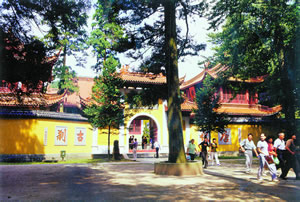 As the days grow slowly warmer, awakening the desire to get out and stretch the limbs, a weekend trip to not-too-distant Yuhang is one of the best ways to escape Shanghai?s forest of steel and concrete.
As the days grow slowly warmer, awakening the desire to get out and stretch the limbs, a weekend trip to not-too-distant Yuhang is one of the best ways to escape Shanghai?s forest of steel and concrete.
Yuhang is 150 kilometers from Shanghai. It is a district of Hangzhou, the capital city of East China?s Zhejiang Province, with plenty of natural attractions and cultural relics in the surrounding countryside.
On arrival at night, a visit to nearby West Lake to enjoy the night scenes on the water is recommended and the cheap amount charged by the local taxi drivers to take you back to the hotel will be another pleasant surprise.
The next morning, try the shuangxi (double-rivulet) drift on a bamboo raft in Jingshan town as the next stop on your sightseeing tour.
Shaoxi Rivulet is the source of Taihu Lake and its water is so incredibly clear you can see the stones on the riverbed and the fish swimming in the water.
The cruise on the bamboo raft goes past groves of luxuriant bamboo, and there?s also some breathtaking excitement as the river has a maximum drop of three meters in the course of the drift.
Next to Jingshan Temple, hidden in a thick bamboo forest at the far end of a zigzag cutting on a mountain?s edge, and which dates back to the Tang Dynasty (AD 618-907).
At its peak, the temple complex boasted 1,000 buildings and 3,000 monks.
It has been identified as the place of origin for Japan?s tea culture and Japanese pilgrims today still make the long trip to the temple every year.
Local women farmers wait at the gate of the temple to sell joss sticks and wax candles to visitors. Sometimes, they even bring along their home-raised poultry for some sales bargaining with nutrition-conscious urbanites.
Take along some mint because the fast descent down the mountain might disturb even city folk, especially when the driver pulls out to overtake other cars on the narrow road.
Yuhang is also famous as the site of ruins and relics from the Liangzhu Culture which have been traced back more than 5,000 years.
In 1994, the United Nations Educational, Scientific, and Cultural Organization included the ruins in a list of the world?s cultural heritage.
For visitors who cannot understand the Chinese narration about the ancient articles on display, the English version inscribed throughout the exhibition gives details of the kind of life the Chinese lived 5,000 years ago: how they farmed, hunted, fished, cooked and made clothes.
That completes almost a one-day tour. For those who want to stay another day, it?s onto the Chaoshan area which is famous for its plum flowers which must be coming into blossom about now.
Remember to drag your feet back to the city before exhaustion sets in. City dwellers have to refresh themselves for work on the coming Monday and the many Mondays ahead.
(Shanghai Star March 28, 2003)
|

